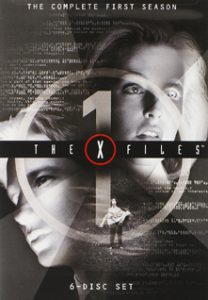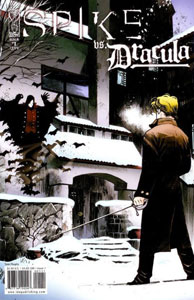When I heard that the “Buffy” Season 5 premiere would be called “Buffy vs. Dracula,” I thought it was a bad idea to bring other people’s characters into a show that was so good at developing its own characters. But the episode won me over as I realized it was about the Scooby Gang’s reaction to Dracula – starting with Buffy thinking it’s cool to meet him – and that approach carries into IDW’s five-issue series “Spike vs. Dracula” (February-June 2006).
In “Buffy vs. Dracula” and throughout his surprisingly robust Season-8-and-beyond “Buffy” comic appearances, Dracula is simply himself. Indeed, Rudolph Martin had played the character in the TV film “Dark Prince: The True Story of Dracula” shortly before his “Buffy” appearance, where he’s essentially reprising his role. True to the lore, the Buffyverse’s Dracula is a little different from a scary Big Bad; although we know he is deadly, he seems more concerned with controlling people and being respected. Yet he never descends into a punchline; as a rare vampire who can morph into a bat, a wolf or mist, he should be taken seriously.
Written by Peter David, whose words are paired with art of varying quality, “Spike vs. Dracula” isn’t so much about fights between the two vampires – although there are some skirmishes – as it is about their personalities as they cross paths at five points throughout history. Spike is annoyed with the Count’s vanity, which has not only made him the most famous vampire but has also taught people how to kill vampires, as per Bram Stoker’s novel/biography. More specifically, Spike wants the 11 pounds Dracula owes him after throwing his Stoker-signed edition of “Dracula” into a fire in 1898. And as you might guess, Darla and the flighty Dru fall under Dracula’s sway, much to Spike’s irritation.
The clash between these two alpha-male vampires provides humor throughout the series, and David also does a nice job of picking out key moments in history in which to set these yarns. Although Angel doesn’t appear until Issue 5, he starts this whole thing by killing a Romani gypsy. After the tribe curses him with a soul, Spike, Dru and Darla slaughter them in retaliation. The tribe, it turns out, was under Dracula’s protection.
Issue 2 jumps to the 1930s, when the famous Hollywood sign reads “Hollywoodland.” Here, David doesn’t skimp on the craziness, as a young Ed Wood saves Bela Lugosi from being killed by Drusilla. This “Forrest Gump”-esque conceit is used again in the much darker Issue 3, when we learn Dracula is in league with Hitler. David keeps the Nazis’ dialog in German rather than translating it, a trick that helps us sympathize with Spike. When a soldier realizes Spike is “ein Englander,” Spike’s nationalism comes out: “Bet der Fuehrer’s mustache, an Englander.” I’ve always found the idea of nationalist vampires amusing, considering that they most likely killed plenty of their countrymen.
David perhaps goes a step too far with continuity tie-ins here, as Spike meets an American werewolf under Nazi imprisonment named Nathaniel Osborne, which is certainly a nod to Oz’s ancestry – but that doesn’t fit because Oz becomes a werewolf by being bitten, not via genetics.

In a darkly comedic Issue 4, Spike and Dru enjoy post-war Rome and Spike mistakenly picks up the scent of a different nemesis. Then the series closes with its most enjoyable entry from a script perspective, set in the Wolfram & Hart offices during “Angel” Season 5 when Spike is in ghost form. He’s thrilled that he can use this to his advantage to haunt Dracula. There are nice moments for Angel and Fred, and Harmony gets a funny through-line about wanting to hook up with the Count.
The art is breezy and sparse in Issue 5, contrasting with the heavy inks of Issues 3 and 4 — that fits with those grimmer, mid-century story tones, although the likenesses are a bit off. The crispest incarnations of Spike, Darla and Drusilla come in Issues 1 and 2. The differing art styles aren’t a problem, though, because “Spike vs. Dracula” isn’t a straight narrative, but rather five instances in the 20th century — and just before and just after — when they cross paths. Spike never forgets about those 11 pounds, though, and David never wavers in giving us a delicious romp.
Click here for an index of all of John’s “Buffy” and “Angel” reviews.

